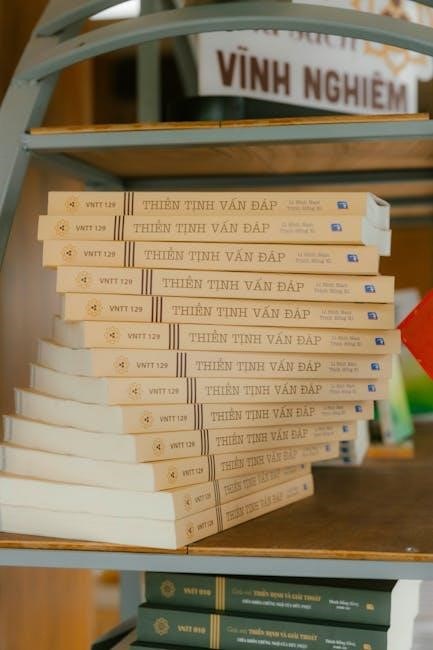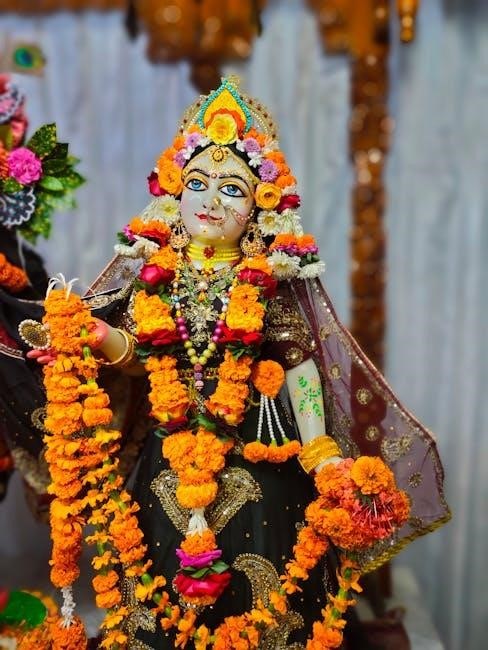Soundarya Lahari, composed by Adi Shankaracharya, is a revered Sanskrit text with 100 verses, divided into Ananda Lahari and Soundarya Lahari, celebrating divine beauty and spirituality.
1.1 Overview of Soundarya Lahari
Soundarya Lahari, meaning “Waves of Beauty,” is a sacred Sanskrit text comprising 100 verses. It is divided into two parts: Ananda Lahari (first 41 verses) and Soundarya Lahari (next 59 verses). Composed by Adi Shankaracharya, it extols the divine beauty and aspects of Goddess Parvati, embodying spiritual bliss and devotion. The text is a masterpiece of poetic and philosophical expression, blending spirituality with art. Its verses are revered for their depth and are often used in worship, meditation, and spiritual practices. The PDF version in Sanskrit is widely available, offering seekers a gateway to ancient wisdom and divine inspiration.
1.2 Historical Significance of the Text
Soundarya Lahari, an 8th-century composition by Adi Shankaracharya, holds profound historical significance as a cornerstone of Hindu spirituality. It reflects the philosopher’s synthesis of Shakti worship and Advaita Vedanta, emphasizing the divine feminine. The text is celebrated for its poetic brilliance and philosophical depth, bridging spirituality and art. Its verses, passed down through centuries, remain central to devotional practices and scholarly study. The availability of the Sanskrit PDF ensures its timeless teachings are accessible, preserving its legacy for modern seekers of spiritual and cultural enlightenment.
1.3 Importance of the Sanskrit Version
The Sanskrit version of Soundarya Lahari is revered for its linguistic purity and spiritual potency. Composed by Adi Shankaracharya, its original form preserves the intricate philosophical concepts and devotional essence. The Devanagari script enhances readability, ensuring authenticity. Roman transliterations and translations aid global accessibility, but the Sanskrit text remains indispensable for scholars and devotees. Its availability in PDF format has made it easier for modern seekers to engage with the sacred verses, maintaining its cultural and spiritual significance in the digital age.

Structure and Composition
Soundarya Lahari is divided into Ananda Lahari and Soundarya Lahari, comprising 100 verses. Its structure reflects poetic excellence, blending spiritual themes with lyrical beauty in Sanskrit.
2.1 Division into Ananda Lahari and Soundarya Lahari
The text is divided into Ananda Lahari (first 41 verses) and Soundarya Lahari (next 59 verses). Ananda Lahari focuses on spiritual bliss and divine joy, while Soundarya Lahari elaborates on the beauty and grace of Goddess Parvati. This division highlights the dual aspects of the divine—bliss and beauty—creating a harmonious balance. The separation also reflects the progression from inner spiritual joy to the external manifestation of divine beauty, making it a comprehensive worship experience.
2.2 Total Number of Verses and Their Significance
Soundarya Lahari comprises 100 verses, symbolizing completeness and spiritual fulfillment. The first 41 verses, Ananda Lahari, reflect blissful experiences, while the remaining 59, Soundarya Lahari, describe divine beauty. Each verse is a profound meditation on Goddess Parvati, embodying philosophical depth and devotional fervor. The total number underscores the holistic nature of the text, blending spirituality and aesthetics. These verses are meticulously structured to guide seekers through stages of devotion, culminating in union with the divine feminine. Their significance lies in their ability to inspire both spiritual growth and an appreciation of divine beauty.
2.3 Style and Language of the Text
The Soundarya Lahari is written in exquisite Sanskrit, employing a poetic and lyrical style. Its language is rich with metaphors and allegories, creating vivid imagery of Goddess Parvati’s divine beauty and power. The verses are structured in a rhythmic meter, enhancing their musicality and recitational appeal. The text seamlessly blends philosophical insights with devotional fervor, making it both a literary masterpiece and a spiritual guide. Its intricate wordplay and symbolic expressions require deep contemplation, offering layers of meaning for scholars and devotees alike. This unique blend of style and language has made it timeless and universally revered.

Sanskrit Script and Transliteration
The Soundarya Lahari is presented in the Devanagari script, ensuring authenticity and readability. Roman transliteration is also provided for easier comprehension, especially for non-Sanskrit speakers. PDF versions include both scripts for accessibility.
3.1 Devanagari Script Usage
The Soundarya Lahari is traditionally written in the Devanagari script, which is widely used for Sanskrit texts. This script ensures the preservation of the text’s authenticity and spiritual significance. The verses are presented in a clear and readable format, making it accessible for devotees and scholars. The use of Devanagari maintains the original pronunciation and rhythm, which are essential for recitation and meditation. PDF versions of the text often include the Devanagari script, ensuring that the sacred verses are accurately conveyed and revered.
3.2 Roman Transliteration for Easy Understanding
Roman transliteration of Soundarya Lahari provides an accessible way to read and pronounce the Sanskrit verses for those unfamiliar with the Devanagari script. This system converts Sanskrit sounds into Latin letters, maintaining the original pronunciation while making it easier for global readers to understand and recite the verses. Many PDF versions include Roman transliteration alongside the Devanagari text, offering a practical tool for spiritual seekers and scholars alike. This approach bridges the gap between traditional Sanskrit and modern accessibility, ensuring the text’s universal appeal and comprehension.
3.4 Availability of Sanskrit PDF Versions
Sanskrit PDF versions of Soundarya Lahari are widely available online, ensuring easy access for devotees and scholars. Websites like sanskritdocuments.org and vaidikavignanam.org offer free downloads, featuring authentic Devanagari script. Platforms such as archive.org also provide PDFs, often accompanied by translations and commentaries. These resources ensure that the sacred text remains accessible to a global audience, preserving its spiritual and cultural significance for future generations. The digital availability of Soundarya Lahari in Sanskrit PDF format has made it easier than ever to explore this timeless masterpiece.

Cultural and Spiritual Significance
Soundarya Lahari holds profound cultural and spiritual significance, revered in Hindu spirituality for its devotion to Goddess Parvati, embodying divine beauty and feminine divinity, inspiring art and music.
4.1 Role in Hindu Spirituality and Worship
Soundarya Lahari plays a pivotal role in Hindu spirituality, serving as a devotional hymn to Goddess Parvati, embodying her divine beauty and strength. It is often recited in worship rituals, particularly during Navaratri, to invoke her blessings. The text is considered sacred, offering spiritual enlightenment and emotional connection to the divine feminine. Its verses are chanted in temples and homes, fostering a deep sense of devotion and inner peace. This ancient Sanskrit scripture remains integral to Hindu religious practices, bridging the mundane and the transcendent.
4.2 Connection to Goddess Parvati and Feminine Divinity
Soundarya Lahari is deeply connected to Goddess Parvati, celebrating her divine beauty, grace, and cosmic motherhood. The text portrays her as the epitome of feminine divinity, embodying both nurturing and transformative energies. Through its verses, the hymn glorifies Parvati as the source of creation, sustenance, and liberation, reflecting the reverence for the divine feminine in Hindu philosophy. The sacred Sanskrit verses are often recited to invoke her blessings, fostering a spiritual connection with her divine essence and highlighting her role as a symbol of cosmic energy and universal harmony.
4.3 Influence on Indian Art and Music
Soundarya Lahari has profoundly influenced Indian art and music, inspiring classical dance, devotional songs, and visual depictions of Goddess Parvati. Its lyrical verses, rich in imagery, have been set to music in various ragas, creating a spiritual and aesthetic experience. The text’s emphasis on divine beauty and grace has motivated artists to create intricate sculptures and paintings, while musicians have composed haunting melodies to convey its emotional depth. This timeless masterpiece continues to be a source of inspiration, blending spirituality with artistic expression in Indian culture.

Downloading and Accessing the PDF
Soundarya Lahari Sanskrit PDF is available for free download from reliable sources like sanskritdocuments.org and archive.org, ensuring easy access to its divine verses and transliterations.
5.1 Reliable Sources for Download
Reputable websites such as sanskritdocuments.org, vaidikavignanam.org, and archive.org provide authentic Soundarya Lahari Sanskrit PDF versions. These platforms ensure the text is presented in Devanagari script, maintaining its original sanctity and readability. Additionally, they often include transliterations, commentaries, and translations, making the document accessible to both scholars and devotees. Regular updates and verification by experts guarantee the accuracy and reliability of the content available on these sites.
5.2 Websites Offering Free PDF Downloads
Websites like archive.org, sanskritdocuments.org, and sanskritebooks.org offer free Soundarya Lahari Sanskrit PDF downloads. These platforms provide authentic versions of the text, often accompanied by transliterations, commentaries, and translations. Some sites also include additional resources, such as MP3 chants and detailed explanations, enhancing the learning experience. Users can easily access these materials without registration or payment, making spiritual and academic exploration convenient and accessible to a global audience.
5.3 Tips for Reading and Understanding the PDF
Start by seeking guidance from scholars or gurus to grasp the deeper meaning. Focus on understanding the context of each verse and its connection to spiritual concepts. Use the provided transliterations to follow along if unfamiliar with Devanagari script. Dedicate time to reflect on the verses, especially those describing Goddess Parvati’s divine attributes. Highlight key passages and revisit them for contemplation. Consider reading aloud to absorb the rhythmic beauty. Explore accompanying commentaries for enriched insights. Finally, create a peaceful environment for study to enhance the spiritual experience and deepen understanding of the text’s profound teachings.

Key Themes and Philosophical Insights
Soundarya Lahari explores themes of divine beauty, spirituality, and bliss, delving into the essence of Shakti and the divine feminine, offering profound philosophical insights into cosmic harmony and existence.
6.1 Themes of Beauty, Spirituality, and Bliss
Soundarya Lahari intricately weaves themes of divine beauty, spirituality, and bliss, describing Goddess Parvati’s attributes and her union with Shiva, symbolizing cosmic harmony. The verses evoke devotion, portraying Parvati as the embodiment of beauty and the source of spiritual enlightenment. They emphasize the bliss of divine union, reflecting the essence of non-dual consciousness. The text also explores the interplay between material beauty and spiritual transcendence, guiding seekers toward liberation through devotion and contemplation of the divine feminine. These themes resonate deeply, offering philosophical insights into the nature of existence and divine grace.
6.2 Exploration of Shakti and Divine Feminine
Soundarya Lahari profoundly explores the concept of Shakti, embodying the divine feminine as the dynamic energy of the universe. The text venerates Goddess Parvati as the supreme Shakti, highlighting her role in creation, preservation, and destruction. Through vivid imagery and sacred verses, it illustrates her as both the consort of Shiva and the independent source of cosmic power. The hymn underscores the unity of Shakti and Shiva, symbolizing the harmony of masculine and feminine principles. This exploration not only elevates the status of the divine feminine but also offers a deep philosophical understanding of her omnipresent and eternal essence in Hindu spirituality.
6.3 Philosophical Concepts in the Verses
Soundarya Lahari delves into profound philosophical concepts, reflecting the essence of Advaita Vedanta. It explores the non-dual nature of reality, emphasizing the unity of the individual self (Jiva) and the universal consciousness (Brahman). The verses intricately describe the interplay between Shiva and Shakti, symbolizing the harmony of masculine and feminine energies. They also delve into the cyclical nature of creation, preservation, and dissolution, offering insights into the cosmic order. Through symbolic language, the text conveys the path to self-realization and liberation, blending philosophical depth with devotional fervor, making it a rich spiritual and intellectual resource for seekers of truth.

Commentaries and Translations
Soundarya Lahari is enriched with detailed commentaries in Sanskrit, offering profound insights into its philosophical and spiritual dimensions. English and regional translations make it accessible to diverse audiences, preserving its essence while broadening its reach.
7.1 Notable Commentaries on Soundarya Lahari
Soundarya Lahari has inspired profound commentaries in Sanskrit, offering deep insights into its spiritual and philosophical essence. These commentaries, written by revered scholars, delve into the text’s mystical dimensions, providing a richer understanding of its verses. Additionally, English translations and detailed commentaries are available, making the text accessible to a broader audience while preserving its original sanctity. These resources are invaluable for both spiritual seekers and scholars, facilitating a deeper connection with the divine wisdom embedded in the text.
7.2 English and Regional Language Translations
Soundarya Lahari is available in English and various regional languages, ensuring its universal accessibility. Translations in Tamil, Telugu, Kannada, and Malayalam are widely popular, offering devotees a deeper understanding of the text. These translations maintain the spiritual essence while making the verses comprehensible to non-Sanskrit speakers. Additionally, English translations provide global audiences with the opportunity to connect with the divine wisdom of the text. Such efforts have ensured that the spiritual and cultural significance of Soundarya Lahari reaches a broader audience, fostering devotion and enlightenment worldwide.
7.3 Comparative Analysis of Different Versions
A comparative analysis of Soundarya Lahari reveals variations across editions, with the original Sanskrit version serving as the benchmark. English and regional translations, while maintaining the spiritual essence, often adapt verses to suit linguistic and cultural nuances. Commentaries by scholars provide deeper insights, enhancing understanding. Some versions include detailed explanations, while others focus on devotional aspects. The coexistence of these interpretations highlights the text’s versatility, catering to diverse audiences seeking spiritual enlightenment, academic study, or devotional practice. Each version, though unique, preserves the core teachings of Adi Shankaracharya’s masterpiece.

Modern Relevance and Applications
Soundarya Lahari remains relevant today, used in meditation, spiritual practices, and rituals. Its verses inspire devotion and provide philosophical insights, making it a valuable resource for modern seekers and scholars.
8.1 Use in Meditation and Spiritual Practices
Soundarya Lahari is widely used in meditation and spiritual practices to connect with the divine feminine. Its verses, rich in spiritual essence, are chanted to invoke inner peace and bliss. The text’s focus on Goddess Parvati’s beauty and power helps devotees transcend worldly attachments, fostering a deeper connection with the divine. Regular recitation is believed to enhance spiritual growth, purify the mind, and attain harmony. It is often incorporated into yoga and contemplation practices, serving as a powerful tool for seekers of truth and enlightenment.
8.2 Incorporation into Rituals and Pujas
Soundarya Lahari is deeply integrated into Hindu rituals and pujas, particularly in worship ceremonies dedicated to Goddess Parvati. The verses are often recited to invoke her divine grace, ensuring spiritual and material well-being. During pujas, devotees offer flowers, incense, and other sacred items while chanting the hymns, believing this pleases the goddess and strengthens their connection to her divine energy. Priests and scholars frequently recite the text during temple rituals, emphasizing its role in fostering devotion and spiritual harmony. This practice underscores its significance in traditional Hindu worship and devotional practices.

8.3 Educational Value for Sanskrit Scholars
Soundarya Lahari holds immense educational value for Sanskrit scholars, offering insights into classical Sanskrit literature and poetic excellence. Its intricate vocabulary, complex grammar, and rhythmic verse structure make it a valuable resource for linguistic study. Scholars can explore the text’s use of metaphors, similes, and philosophical depth, which reflect the richness of ancient Indian thought. The hymn’s blend of spirituality and aesthetics provides a comprehensive understanding of Sanskrit aesthetics and devotional literature. It remains a cornerstone for scholars seeking to master classical Sanskrit and delve into the cultural and philosophical heritage of India.

Challenges and Considerations
Interpreting Sanskrit verses requires deep linguistic and philosophical understanding, while preserving the text in the digital age poses challenges for authenticity and accessibility.
9.1 Difficulty in Interpreting Sanskrit Verses
The intricate language and profound philosophical concepts in Soundarya Lahari make its verses challenging to interpret. The Sanskrit text, rich in metaphor and spiritual symbolism, requires deep linguistic expertise and cultural context. Many seekers struggle with the esoteric meanings embedded in the verses, which are often layered with Vedic philosophy and tantric principles. Without proper guidance, the subtle nuances and spiritual depth of the text may remain elusive, even for knowledgeable readers. This underscores the need for scholarly commentaries and translations to unlock its full significance.
9.2 Need for Guidance from Scholars
Understanding Soundarya Lahari’s profound verses often requires guidance from scholars, as its Sanskrit text is deeply rooted in Vedic philosophy and spiritual symbolism. The intricate concepts and esoteric meanings necessitate expertise to decipher accurately. Scholars provide contextual insights, unraveling the layers of metaphors and philosophical depth. Their interpretations bridge the gap between the ancient text and modern readers, ensuring the true essence of the verses is preserved and accessible. Reliable commentaries and translations, available in PDF formats, further aid in comprehending this sacred work, making it invaluable for spiritual seekers and scholars alike.
9.3 Preserving the Text in the Digital Age
Efforts to preserve Soundarya Lahari in the digital age involve maintaining its authenticity while ensuring accessibility. Reliable websites like sanskritdocuments.org and archive.org offer free PDF downloads, safeguarding the text for future generations. Digital libraries and platforms dedicated to Sanskrit literature play a crucial role in this preservation. These initiatives ensure that the sacred verses remain accessible to spiritual seekers and scholars worldwide, maintaining their integrity and promoting their cultural significance in a rapidly changing world.
Soundarya Lahari, a masterpiece by Adi Shankaracharya, remains a cornerstone of spiritual and cultural heritage. Its divine verses, available in Sanskrit PDFs, continue to inspire devotion and scholarship, ensuring its timeless relevance in the digital age.
10.1 Summary of Key Points
Soundarya Lahari, a revered Sanskrit text by Adi Shankaracharya, consists of 100 verses divided into Ananda Lahari and Soundarya Lahari, blending spirituality and aesthetic beauty. The Sanskrit version, written in Devanagari script, is highly valued for its linguistic and philosophical depth. It is widely available as a free PDF from reliable sources like sanskritdocuments.org and vaidikavignanam.org. The text explores themes of divine beauty, Shakti, and spiritual bliss, influencing Indian art and music. Its verses are used in meditation, rituals, and worship, making it a cornerstone of Hindu spirituality and a valuable resource for Sanskrit scholars.
10.2 Final Thoughts on the Significance of Soundarya Lahari
Soundarya Lahari, a timeless masterpiece by Adi Shankaracharya, holds profound spiritual and cultural significance. Its verses, available in Sanskrit PDFs, beautifully blend devotion with philosophical depth, making it a cornerstone of Hindu spirituality. The text’s exploration of divine beauty, Shakti, and bliss continues to inspire seekers and scholars alike. Its influence on art, music, and rituals underscores its enduring relevance. As a free resource, it remains accessible to all, preserving ancient wisdom for future generations while fostering a deeper connection to the divine feminine and spiritual enlightenment.
10.3 Encouragement to Explore the Text
Embark on a spiritual journey with Soundarya Lahari, a masterpiece of divine poetry. Its profound verses, available in Sanskrit PDFs, offer insights into beauty, spirituality, and bliss. Whether you seek enlightenment or a deeper connection to the divine feminine, this text is a timeless guide. Accessible from reliable sources, it invites devotees and scholars alike to explore its wisdom. Let the waves of beauty and bliss inspire your soul, fostering personal growth and spiritual understanding. Dive into this sacred work and uncover its treasures for a transformative experience.

Be First to Comment